Time and tide wait for no man. Technologies change rapidly and change the world. The winner is always the one who offers faster and more efficient solutions, staying one step ahead of the rest.
So, you should improve your software development process with doubled eagerness. And here, a DevOps engineer comes to assist.
Any code release within the IT sphere is the result of the coordinated work of two teams - the development of a software product and IT maintenance. And the DevOps methodology appeared to organize their productive interaction. Over time, this methodology has been transformed into a full-fledged profession.
In this article, we will answer the question: who is a DevOps engineer? You will know why hiring DevOps engineers is essential to speed up and increase the efficiency of the development process.
So, let’s consider what DevOps engineering practices everyone talks about but not many understand.
Who is a DevOps engineer, and what do they do?
It would be wise to begin with the definition. DevOps combines philosophies and practices that speed up an organization’s delivery time. This means helping to evolve and enhance apps and services faster than businesses using traditional infrastructure management and web development processes.
The term DevOps consists of two parts: Dev (development) and Ops (operations). This is a well-known conflict between ops and dev teams. The history of the battle is really long.
In short, development and operations teams have different goals. The development teams aim to deploy features and change products to fit market needs as fast as possible. At the same time, the operations teams want to provide a stable, reliable, and secure product.
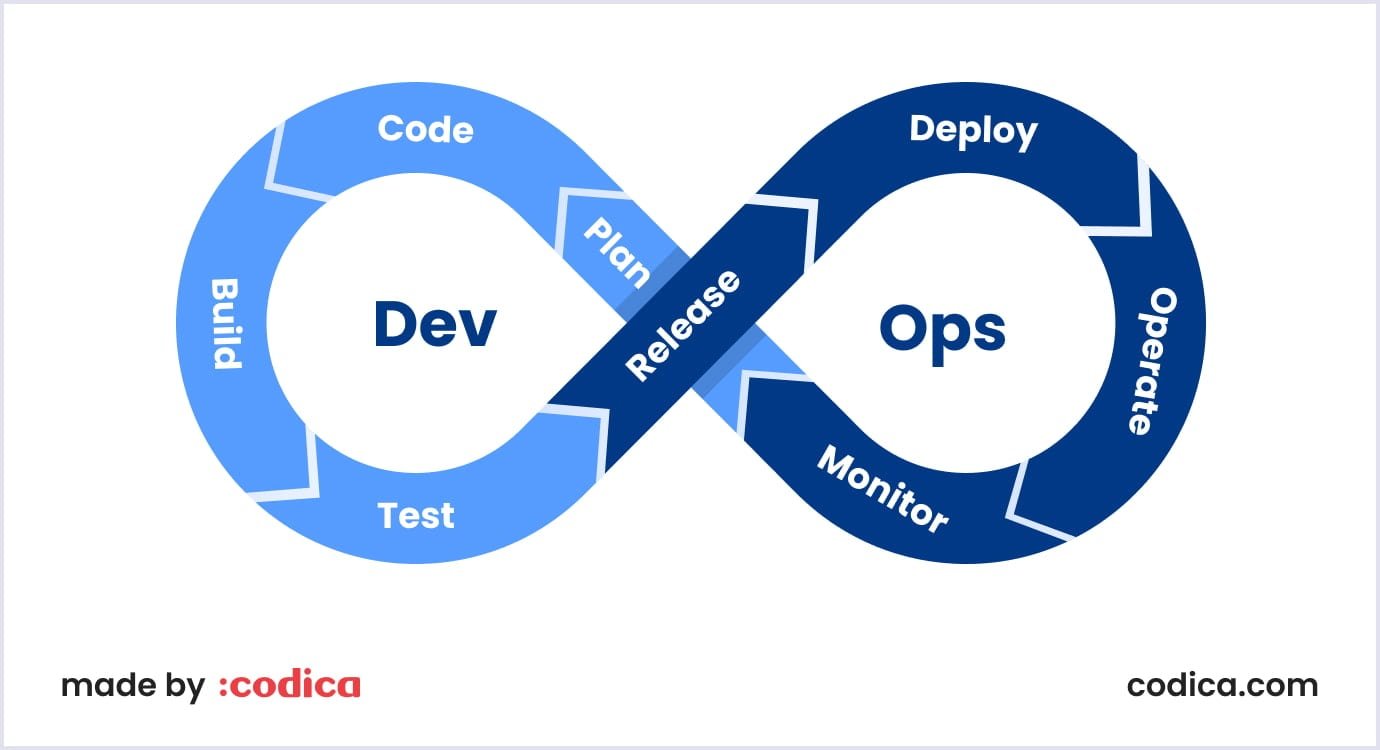
DevOps is a collection of methodologies outside of IT in the first place. DevOps was developing and improving in manufacturing, management, and many other fields. It was well described in The Phoenix Project book, where the authors compare the software development process and manufacturing pipeline.

And you can clearly see the same logic works for IT. The raw materials are code, and the final product is application deployment. The competition between development and operations teams would slow down all development processes. DevOps engineers unite these directions in one and help collaborate better and deliver software products faster.
What is the role of the DevOps engineer?
Now, let’s consider the question: what does a DevOps engineer do? DevOps is an expert who synchronizes the work of system administrators and programmers. This specialist automates their tasks to speed up the release of software and the release of updates to them.
A DevOps engineer has great scripting skills and understands the basics of programming languages. They often have system administration, web, or mobile development backgrounds.
The DevOps engineer skills help to avoid extra financial costs and significantly increase the speed and quality of development. Also, the DevOps expert conducts effective debugging or scaling of the solution.
The tasks of the DevOps engineer depend on the structure of the company and the features of software products. In general, the responsibilities of a DevOps engineer include the following aspects:
Optimization of the IT infrastructure of the product
DevOps engineers offer solutions for optimizing the current infrastructure. This is necessary to speed up the release of the product or its update to the market.
Automation of release processes
One of the most important daily tasks of the DevOps engineer is to reduce code releases time. For this, the expert configures the equipment and automates certain processes with various automation tools. For example, the DevOps professional automates typical repetitive tasks and also develops useful plugins. These are Ansible, Bash, Chef, Salt, and others.
Testing systems daily
The successful DevOps engineer is also an agent of rapid response. They support the project's infrastructure, responding to hardware and software changes. The DevOps engineers also monitor working processes throughout the entire software development lifecycle.
Providing feedback to software developers and testers
This helps to quickly identify and fix issues and bugs in terms of the DevOps process. The constant feedback helps the development team quickly deal with impediments while they are little, low-cost, and easy to remove.
Ensuring security
The DevOps engineer applies automated tools for developing digital pipelines. They are the CI/CD/CD (continuous integration, delivery, and deployment) pipelines. CI means automated testing whenever developers make any changes to the repository.
CD means continuously delivering and deploying code to an environment (QA, production). And the other CD stands for continuous deployment - the practice of automating the entire software release process. CI/CD/CD pipeline is the core of the software development process. So, ensuring its security improves the overall app's security state.

How our DevOps engineers work on the projects
At Codica, we develop high-quality web and mobile solutions. And DevOps engineers play an essential role in the software development life cycle. They help optimize all business processes and speed up development.
For example, recently, we worked on a complex project - a SaaS website for bakery businesses. It is called CakerHQ. It allows customers easily find and book desserts. Also, this Australian SaaS platform optimizes business administration. We made this solution eye-catching, secure, and intuitive.
As a result, our client received a secure and robust solution that drives traffic and sales. Below is a video that shows how CakerHQ operates in real life.
Let’s consider what our DevOps engineers did, taking this project as an example.
- DevOps engineers planned the architecture for the project in AWS (Amazon Web Services): what AWS services we used, what for, and how. These include networking and databases, caching clusters, and sockets to improve end-user experience with services like AWS Global Accelerator.
- We wrote infrastructure as a code (IaC) for the CakerHQ in Terraform and made sure to keep it secure. Terraform is one of the top software tools for implementing IoC. It allows the building and updating of the AWS infrastructure. Moreover, our DevOps engineers configured CI/CD for infrastructure that verified if our architecture was secure and stable.
- DevOps engineers configured CI/CD for both the front and back end from the first to the last step.
- DevOps engineers wrote Dockerfile and tested all container-related things. Dockerfile is a text file comprising all commands Docker needs to build an image. At Codica, we like Docker as a great set of tools for speeding up development.
- Our experts ensured they worked properly and that nothing was missing inside the containers. This was made for both the back end and the front end.
- We also configured continuous monitoring and alerting systems for this project. Thus, if the web page did not respond or the server ran out of memory, we would be notified about this in a few seconds.
- DevOps engineers configured monthly usage reports for the client.
- Our DevOps team also configured required access for developers, including both access to AWS (optionally) and servers. Also, DevOps experts ensured access security.
- Our DevOps engineers wrote the required automation. This helped eliminate bottlenecks and reduced failures and data losses. Also, implementing DevOps improves communication skills across departments, transparency, and processing speed.
- Moreover, our DevOps team provided tech help to developers. For example, DevOps engineers help developers build the app if they have difficulties. Also, the DevOps team helped with debugging in staging and production. The staging is an intermediate version of the site and layout for testers. And production is an environment where your product is available to users.
- Finally, DevOps engineers configured error-tracking systems like Sentry.
- After the CakerHQ project launch, we optimized costs upon the client’s request.
You have already noticed that the DevOps engineer’s everyday work includes many tasks. Our primary goal is to deliver high-quality products to our clients. For this, we use modern and proven software development kits.
With these development and deployment tools, our DevOps engineers optimize software development efficiency. Furthermore, DevOps services enable changes to the solution to be more cost-effective and enhance mistakes tolerance.
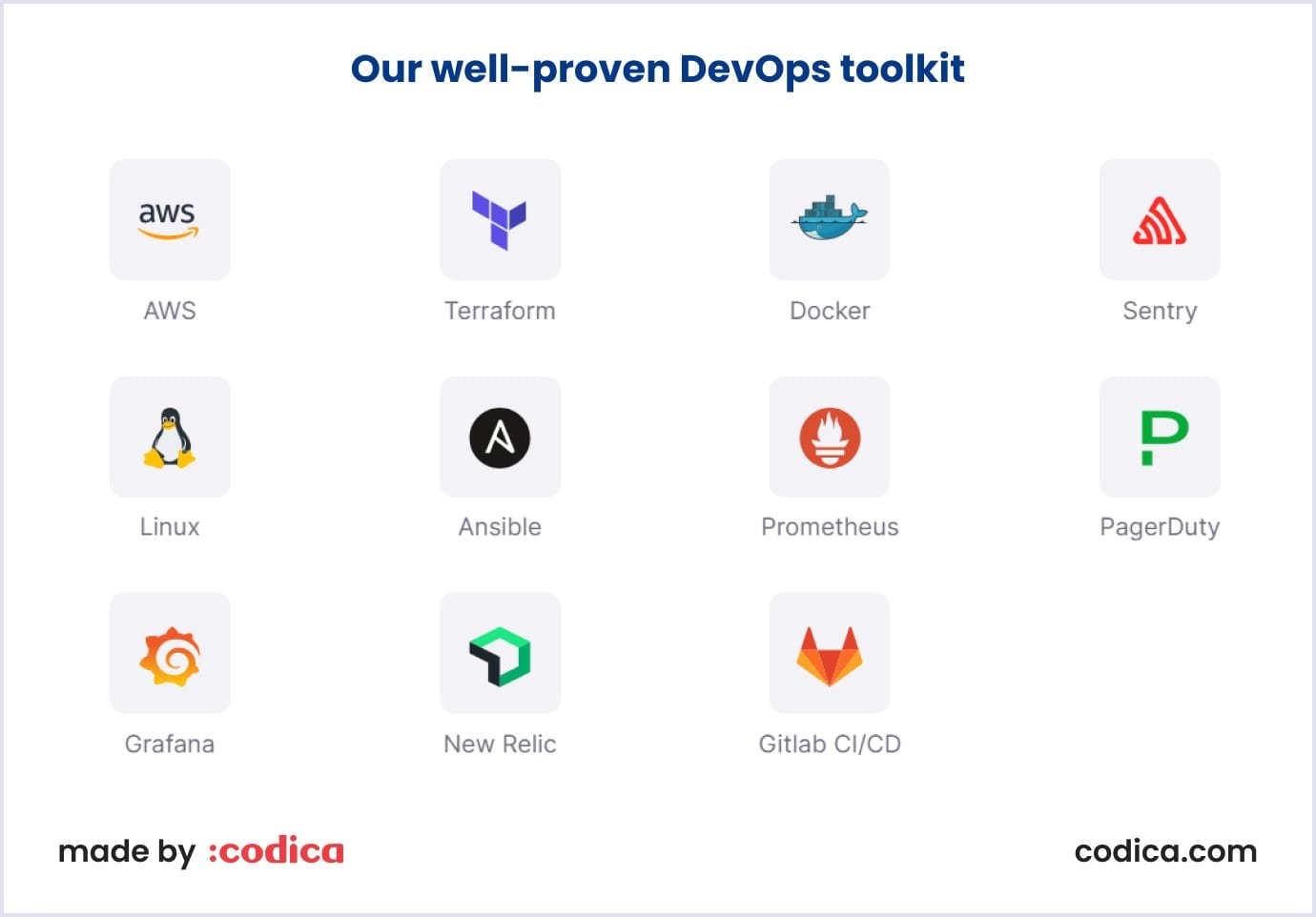
Why does your startup need DevOps services?
Well, we figured that DevOps is an essential part of the modern IT team. Let's nail it and answer why DevOps presence is so crucial and what benefits it will bring to your business.
DevOps is healthy for the whole team
Gene Kim, the author of the DevOps handbook, and Project Phoenix, in his interview, mentioned conditions that IT should follow. This helps to avoid main faults and achieve success in web development. These conditions are the following:
- Locality and simplicity;
- Improvement of daily work;
- Focus, flow, and joy;
- Psychological safety;
- Customer focus.
All these points are really crucial nowadays, as many developers are facing burnout. DevOps affects the developer’s productivity because they receive quick feedback on their work quality.
DevOps allows you to test and experiment
If you use DevOps services, the risks of failure are much lower. For example, 1959 is the starting point for the so-called Mainframe era in the DevOps world. It was the era of highly centralized computing managed by programmers and system operators.
At that time, the mistake was expensive. If you fail to deliver some feature at some point in time, this can bring your company to bankruptcy and massive layoffs.
Below you can see the mainframe invasion cycle. It shows the failure costs if you apply the traditional web development approach.
| Cost | 1$ million - 100$ million |
| Duration | 1 to 5 years |
| Cost of failure | Bankrupt or bought |
But in the modern world, if you use a modern DevOps approach, risks are much lower. See the table below to compare it with the previous one.
| Cost | $10k - $1 million |
| Duration | 2 to 12 weeks |
| Cost of failure | Business reputation |
Source: Adrian Cockcroft “Velocity and Volume (or SpeedWins)”
Faster deployment
The DevOps engineers provide a much more predictable deployment workflow. So, deployments happen all the time during the day. The DevOps services effectively replace outdated workflow. With the outdated flow, deployments started, for example, at the end of Friday, and the IT Ops team should spend the whole weekend trying to fix this.
Also, the DevOps professional helps teams deploy hundreds of times daily. This approach means making small changes that do not negatively affect customers. In general, all the workflow with DevOps allows the whole development team to have a fast feedback loop.
Fast feedback loop
Let us suppose a world where DevOps is not in place yet. In this case, the deployments can take months.
There is a term called lead time mentioned above. For example, a new feature was requested. And lead time is the time that comprises all process that takes from the client's request to its fulfillment. With DevOps, we have many deployments a day. Thus, we can easily and quickly satisfy requests.
Below is a diagram that demonstrates the cycle of lead time.
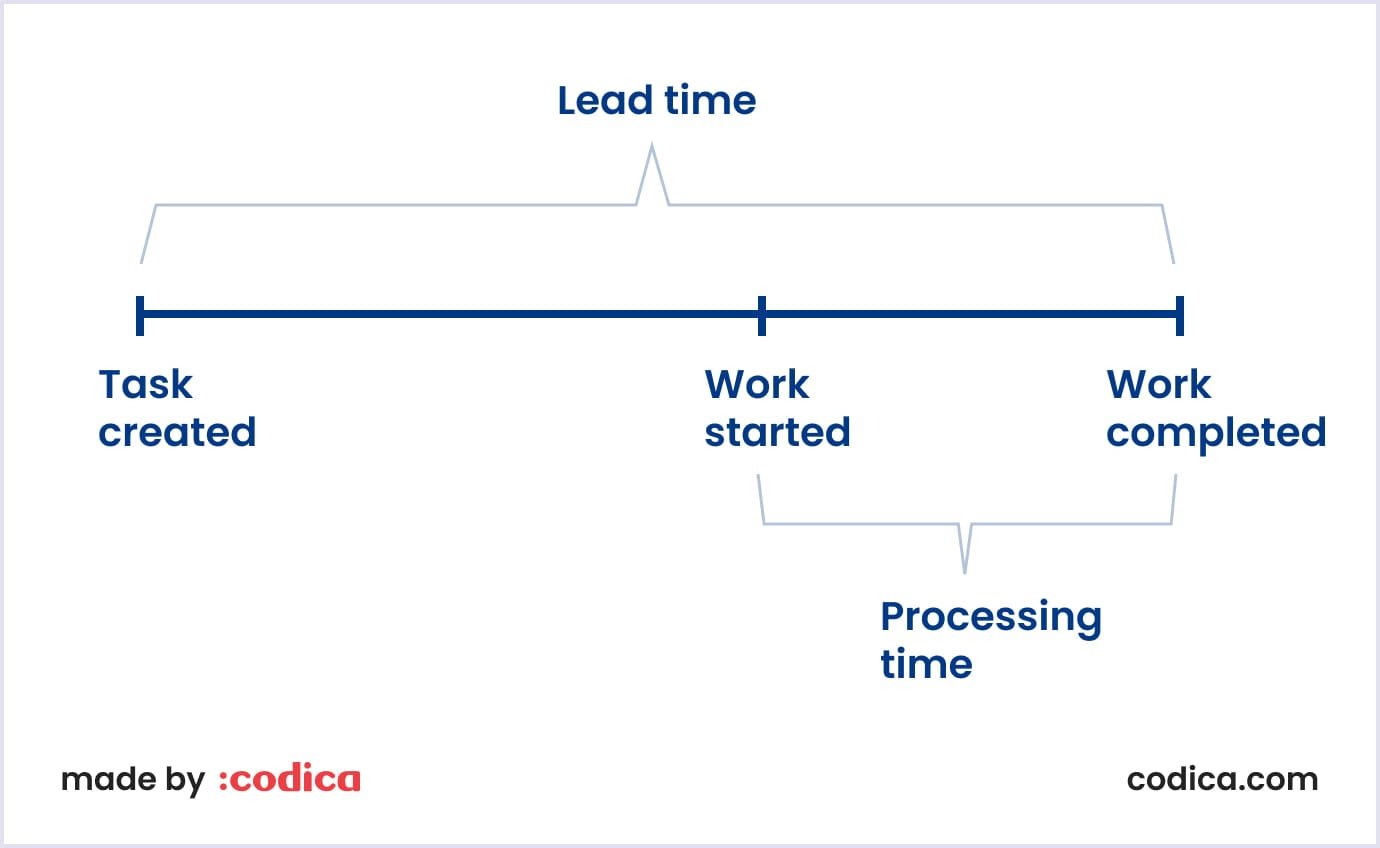
But let's consider we have one deployment in three months, for example, like before DevOps. So, the entire deployment process will turn into a chaotic pattern.
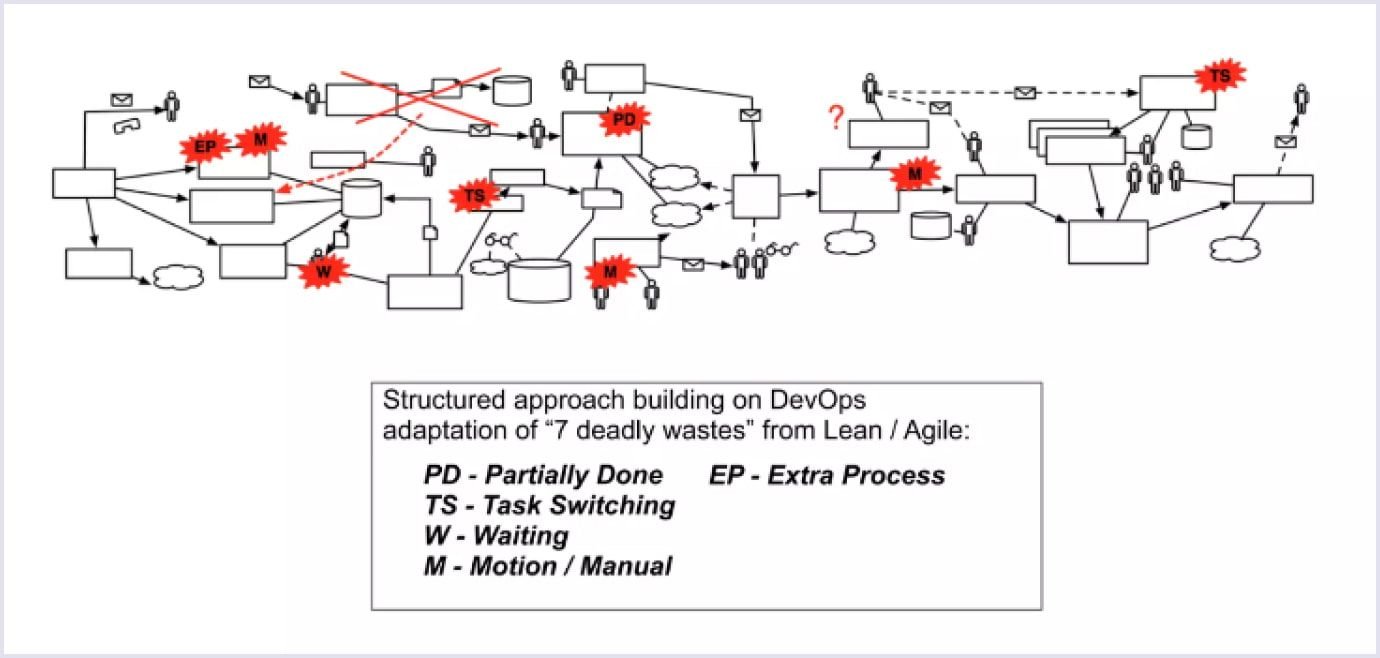
Source: Gene Kim, Jez Humble, Patrick Debois, John Willis, The DevOps Handbook
The ability to do many deployments helps DevOps engineers to see the changes faster. When modifications are committed to the source repository, all the magic happens. The repository includes the build, tests, and security scans and deploys the app to a production-like (staging) environment. Using the staging environment, the quality assurance (QA) team can check all product features. And if QAs approve bug fixes, the project can be deployed to production in approximately 15 minutes.
With DevOps, your lead time will be similar to the numbers you see in the picture.
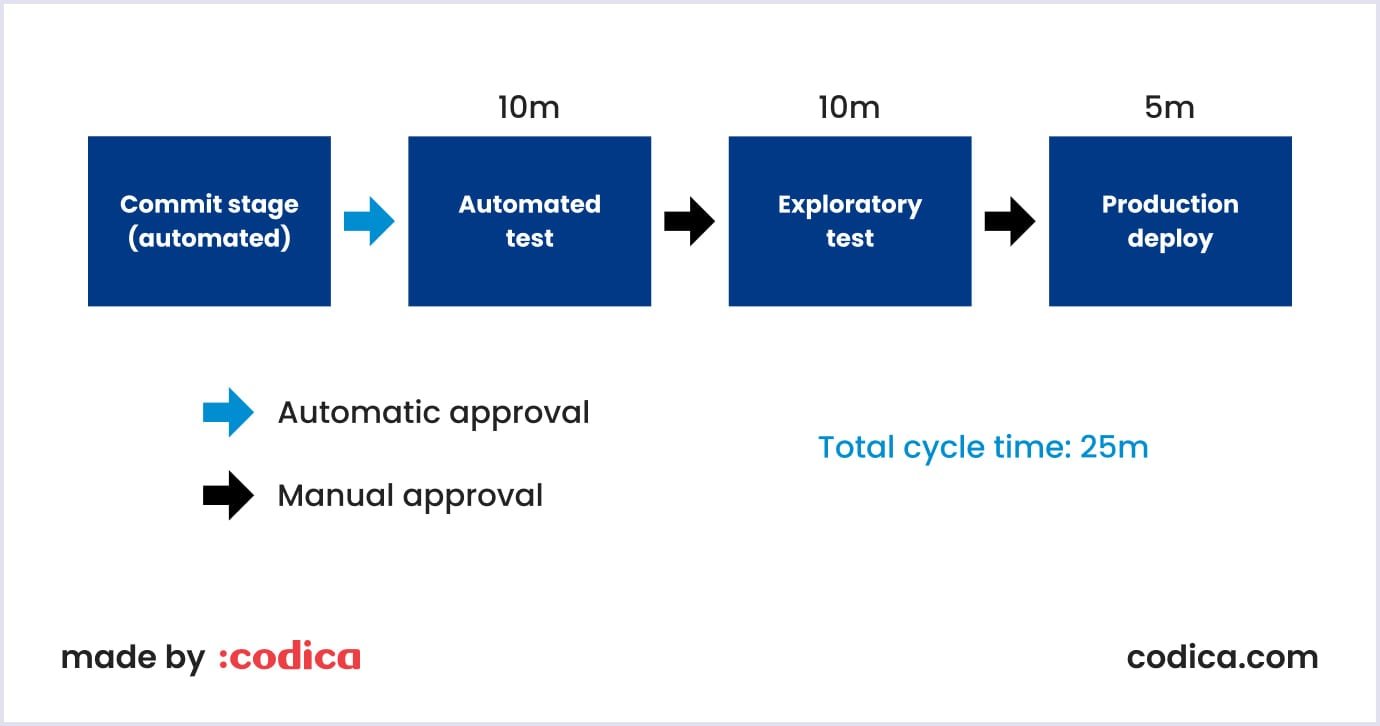
Source: Gene Kim, Jez Humble, Patrick Debois, John Willis, The DevOps Handbook
Automated testing
Automation testing helps software developers to learn from their mistakes quickly. Without the DevOps engineers, they would find their bugs in a few months. Instead, automated tests raise application quality and help developers conduct tasks faster.
When there are a lot of little modifications, it results in much better quality. So every team member feels much more productive. Moreover, the earlier you find a bug, the less money you will spend to fix it later.
In general, DevOps engineers help teams to build a collaborative and trusting culture without fears of making mistakes.
Postmortems and learning from mistakes
The postmortem culture is well-established in the tech industry. A postmortem is a written incident record. This record reflects the impact, the root cause of an incident, and the steps taken to resolve it.
The main aims of writing a postmortem are to make sure that the incident is well-documented and that all causes are understood. A postmortem also shows which special operations should be done to prevent the likelihood of incident recurrence.
Postmortem culture existed long before DevOps, but it has become an essential part of it. Blameless postmortem culture was introduced to prevent people from fear of telling that they made a mistake. For example, Etsy states that this approach helps build a culture of learning and enhances performance over time.
In short, postmortems help teams to do the following:
- Build a healthy culture between project teams;
- Decrease the risk of ignoring issues for fear of blame;
- Develop an open, constantly-improving culture of learning;
- Allow more time for teams to perform their best work;
- Enhance communication and support.
If you are interested in more details about postmortems and incident management, you can check Atlassians’s Incident Management Handbook.
Deployments scaling
Indeed, adding DevOps to a project team will increase team productivity. Increasing team size without DevOps engineers makes each developer's work less effective. The more people you have, the worse is communication between them. But DevOps helps you keep teams of thousands of people highly productive.
Let's see a diagram below that shows the number of deployments depending on the number of developers. With the growing team of developers, the high performers deploy (yellow line) happen more frequently.
To scale deployments per “day per developer,” we should pay attention to all the aspects that provide high IT performance. These are a goal-oriented generative culture, a culture of learning from mistakes, effective leadership, and engineering practices that allow continuous delivery.
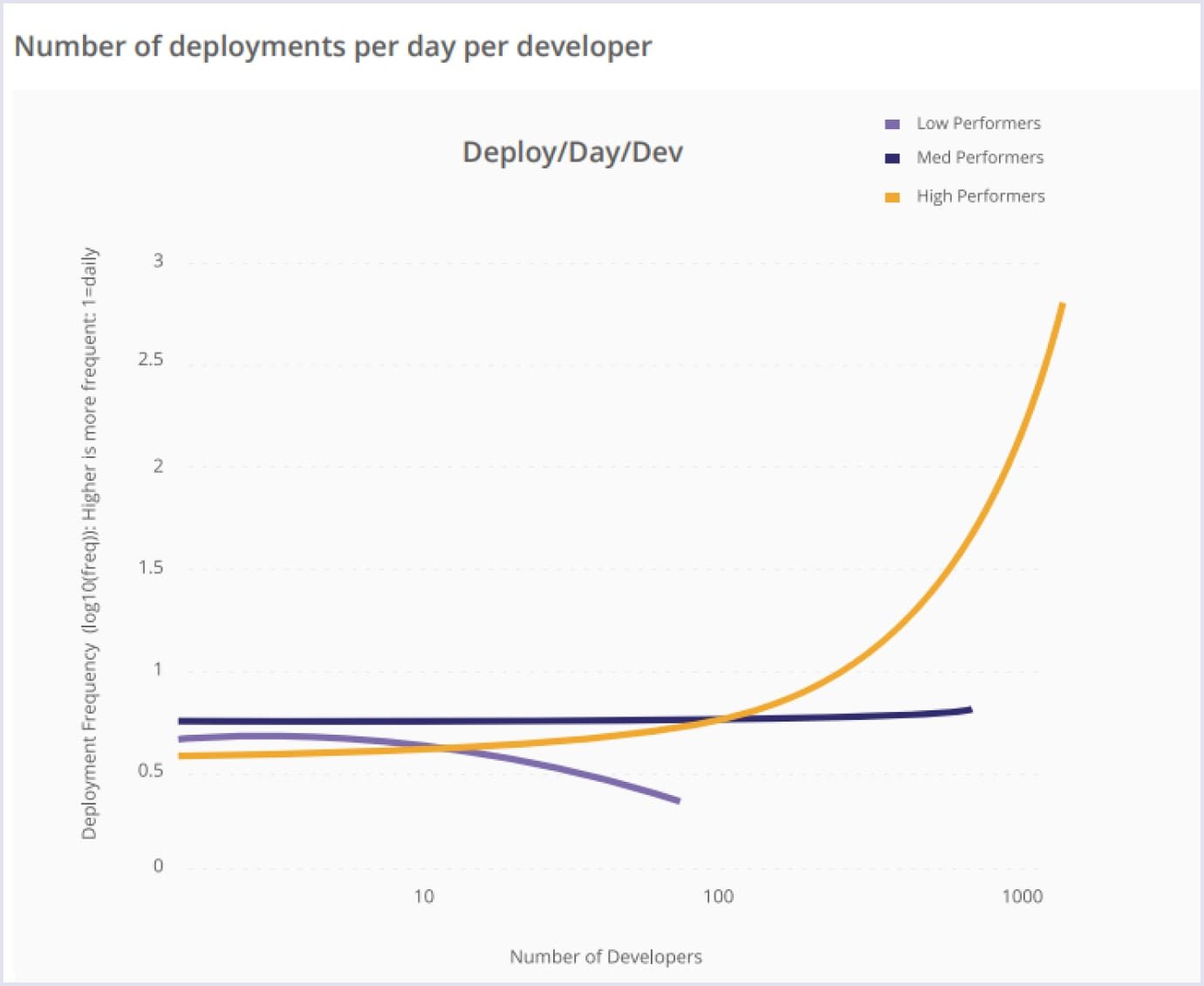
Source: State of DevOps Report
DevOps: the roots
DevOps as a movement started between 2007 and 2008. This movement railed against the traditional web development model. The traditional model brought those who write code to be operably and organizationally apart from experts who deploy and support that code. But the newly-born DevOps approach united the operations and developers' teams. So, their goals are pointed in the same direction.
For a deeper understanding of DevOps engineer roles, let’s dive into the history of this methodology and what affected its creation.
Sometimes people compare lean, agile, and the DevOps lifecycle, trying to find a line of distinction between them. Still, these methodologies are connected. If we turn to history, lean led to agile, and the last evolved into DevOps.
The lean movement started with Toyota. In 1950, Eiji Toyoda, a nephew of Toyota's founder, had a three-month visit to the Ford plant. He knew that she had a lot to learn from Ford. At that time, the Ford company was making about 7000 cars a day while Toyota produced just about 2685 a year.
If we compare General Motors Framingham (Ford) and Toyota at that time, the difference is insane:
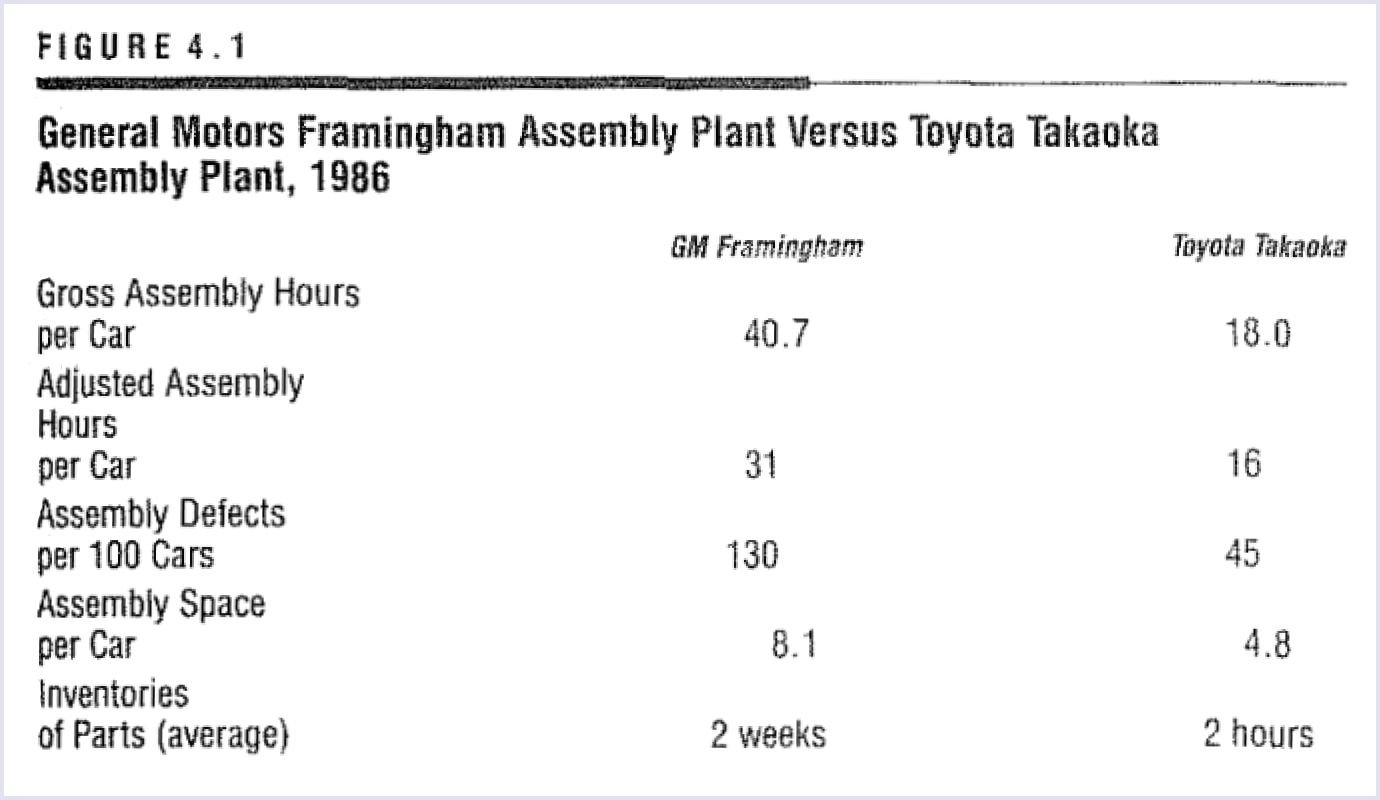
Source: James P. Womack, The Machine That Changed the World: The Story of Lean Production
But the Toyota market in Japan needed much more additional functionality of cars, while Ford’s goal was mass production. So, their manufacturing would not be suitable for Toyota. Toyota experimented extensively and came up with Toyota Production System (TPS). Below you can see a diagram that reflects the TPS system.
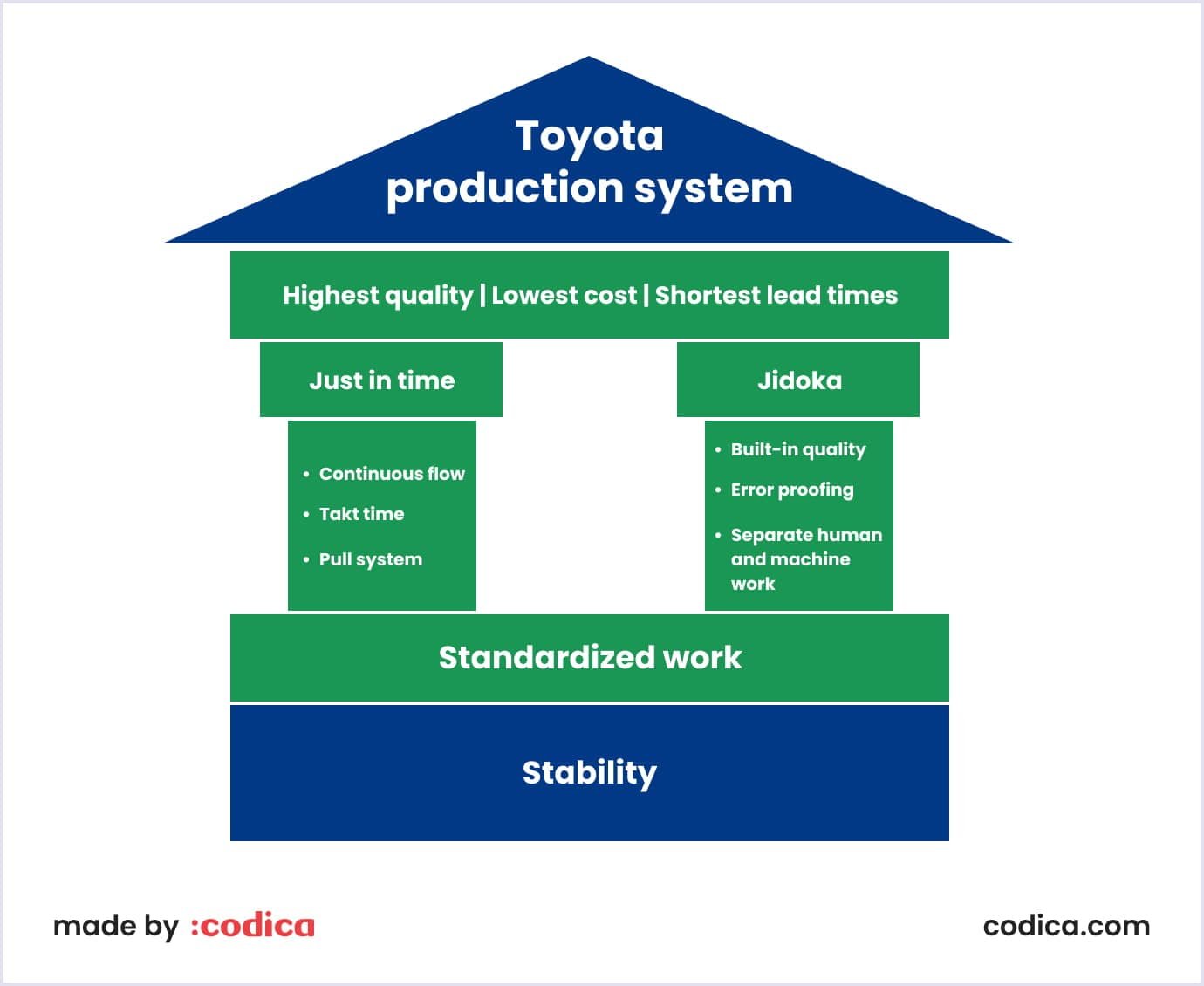
TPS is based on the following principles:
Quality at the source
This principle aims to ensure quality on each step on the first try. So this will shorten the delivery journey and operational expenses. This principle connects with the goal of the DevOps engineer to deliver quality software on time.
Just-in-time
It means all the production chain steps are divided according to the client's demand rate.
Continuous improvement
Continuous improvement via daily learning is a key principle of TPS. Because of day-to-day visual management, DevOps teams can see and learn from their mistakes. Also, DevOps engineers can dedicate time to retrospectives that will allow them to improve work processes.
The lean movement was born as an attempt to systematize TPS and its ideas with the following key principles:
- Determine value from the viewpoint of the end customer by product family.
- Define all the stages in the value flow for each product family. Eliminate those stages that do not offer value.
- Let the value-adding steps occur in a strict sequence so the product will flow seamlessly toward the user.
- As flow is implemented, let users extract value from the next upstream activity.
- So, point out the value, identify the value streams, remove wasted steps, and introduce flow. After that, start the process again and pursue it until perfection is achieved. In this case, the excellent value should be created with no waste.
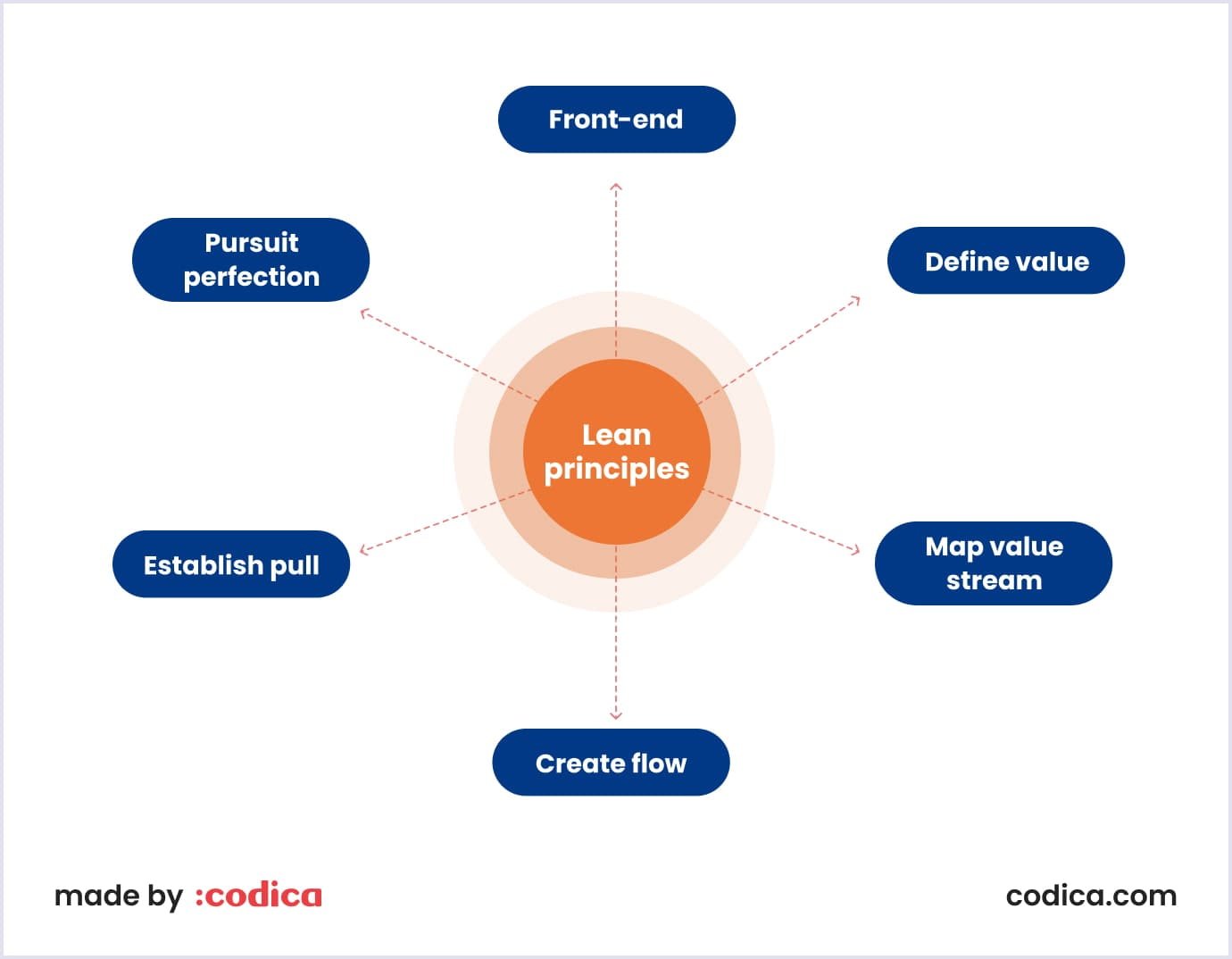
Now let’s consider how the agile methodology influenced the creation of the DevOps philosophy.
Agile is an interactive web development approach. It means product development in small steps while constantly analyzing what was done. This approach aims at efficiency, flexibility, and collaboration, which enable teams to create quality projects.
In 2001 agile manifesto was created, and they have twelve principles. But we will highlight the most important ones:
- Deliver working software often, focusing on a shorter timescale;
- Clients and developers must collaborate throughout the project;
- Create solutions with motivated specialists. Provide them with the environment and assistance they need, and trust them to conduct the job;
- The key measure of progress is working software;
- The highest-quality requirements, architectures, and designs result from self-organizing teams.
So agile particularly predicted DevOps. Moreover, DevOps is often seen as a continuation of agile. Why? Because it develops more practices on top and makes existing ones better.
One of the fundamental DevOps practices is CI and CD we mentioned at the beginning of the article.
The continuous delivery movement started at the agile conference in 2006. The idea was to make coding automatic. The precise definition of the message states, “Continuous Delivery is the ability to get all types of modifications, comprising configuration changes, bug fixes, new features, and experiments - into production, or into the hands of users, quickly and safely in a sustainable way.”
The continuous delivery movement was based on the five main principles:
- Work in small batches;
- Build quality in;
- Computers perform repetitive tasks, people solve problems;
- Relentlessly pursue continuous improvement;
- Joint responsibility.
Since 2007, the velocity conference has existed, and it has made a huge impact on culture and DevOps specifically. There was the seminal speech, “10 Deploys per Day: Dev and Ops Cooperation at Flickr”. In particular, this speech gave birth to the "DevOps" word.
Three ways of DevOps
The concept of “The Three Ways” explains the tenets of the DevOps movement.
The Three Ways are the principles from which all DevOps patterns can be derived. These patterns are well described in The DevOps Handbook and The Phoenix Project: A Novel About IT, DevOps, and Helping Your Business Win.
These Three Ways are closely mutually-related. They all help us underpin our DevOps processes at the company. So, what are those ways?
The first way: flow/systems thinking
The first way puts performance on top of everything. For example, it can be the performance of the whole department or one team member individually.
The main goals of the first way in DevOps are as follows:
- Work must flow in one specific direction.
- Defects can not be passed downstream.
- Always seek to enhance the flow.
The results of following the first way in practice are that known bugs are never passed on to the next work stage. Local optimization resulting in the creation of global degradation is never developed. This way implies continuous improvement and the desire to deeply understand the system.

The second way: feedback loops amplification
The second way is built on a feedback loop. Its goals are related to feedback loops and are as follows:
- Establishing an upstream feedback loop.
- Shortening the feedback loop.
- Amplifying the feedback loop.
If the system works fine, the feedback loop will help you to optimize the value stream.
The second way is about making a right-to-left feedback loop. Almost any process improvement initiative aims to reduce and amplify feedback. So that necessary adjustments can be made continuously.
The results of the second path are understanding and responding to all requests, both internal and external. It means the reduction and strengthening of all feedback loops. The second way involves deepening knowledge about the environment where it is needed.

The third way: culture and environment
This way explains the culture of continual experimentation and learning. Its key principles include the following:
- Promoting experimentation.
- Learning from both failure and success.
- Improving constantly.
- Seeking to reach mastery with practice.
Ideas of the third way show us that the development culture is as essential as the development results. This way also highlights the importance of experimentation and learning from your successes or mistakes.
The third way is about risk-taking and experimentation. It ensures we keep improving, even if we face risks. And we must learn DevOps skills that can help us get out of the risk zone when we have gone too far.
The results of following the third path include allocating time to improve day-to-day work. This way means creating rituals that encourage the team to take risks. In addition, the third way involves the possible creation of faults in the system to increase its stability in the future. Because we already have the experience to overcome them.

Summary
DevOps engineer skills are essential for any IT company. The DevOps methodology was born as the logical continuation of many movements and practices. And it will continue to develop. Many giants like Amazon, Google, and Netflix have already implemented DevOps practices, and many are on the way to this. Nowadays, it's nearly impossible to survive in modern IT without following and understanding DevOps ideas.
If you are looking for a reliable DevOps company to improve your business performance, contact us. We have already helped many businesses to grow and scale.
